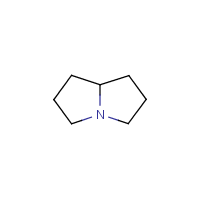Pyrrolizidine
Agent Name
Pyrrolizidine
CAS Number
643-20-9
Formula
C7-H13-N
Major Category
Biological Agents

Synonyms
1-Azabicyclo(3.3.0)octane; 1H-Pyrrolizine, hexahydro-; Hexahydropyrrolizine; [ChemIDplus]
Category
Plant Toxins
Sources/Uses
Not commercially produced in the US; [HSDB]
Comments
Emergency treatment: "Plants- pyrrolizidine alkaloids"; Pyrrolizidine alkaloids (PAs) cause veno-occlusive liver disease. Diagnosis is difficult because symptoms may be delayed for days or weeks. After drinking herbal tea or eating plants contaminated with seeds of PA plants, symptoms may include vomiting, abdominal pain, hepatomegaly, and later cirrhosis and ascites. Jaundice may be present. Children may appear to have Reye's syndrome. [HSDB] Plants containing significant amounts of pyrrolizidine alkaloids are found all over the world, comprising about 3% of all flowering plants. They have long been known to be toxic to livestock. Outbreaks of poisoning cases in humans after food contamination have been reported, and the problem is endemic in some central Asian republics. [Reference #1] Teas containing PAs include coltsfoot, comfrey, gordolobo, groundsel, mate, tansy ragwort, and T'u-san-chi. The teas may be prescribed as herbal remedies for anxiety or amenorrhea. The alkaloid is concentrated in the root of the plants. As little as 85 mg may be toxic. [Haddad, p. 1082] Over 6000 plants produce pyyrolizidine alkaloids, some of which are toxic. This is probably the most common plant toxin, and it affects livestock, wildlife, and humans. [Haddad, p. 494] Mechanism of toxicity is the metabolic conversion into pyrroles that act as alkylating agents. Hepatic disease leads to cirrhosis and possibly increased risk for hepatic carcinoma. Most poisoning cases have resulted from contamination of food grain with the seeds containing the alkaloid or from medicinal herbs. An estimated 20% of patients die, 50% recover completely, and 30% develop chronic hepatic veno-occlusive disease. [Goldfrank, p. 647, 1546]
Reference Link #1
Biomedical References
Adverse Effects
Hepatotoxin
Hepatoxic (a) from occupational exposure (secondary effect) or (b) in animal studies or in humans after ingestion
Diseases, Processes, and Activities Linked to This Agent
Other Information
No other related information on this agent was found.